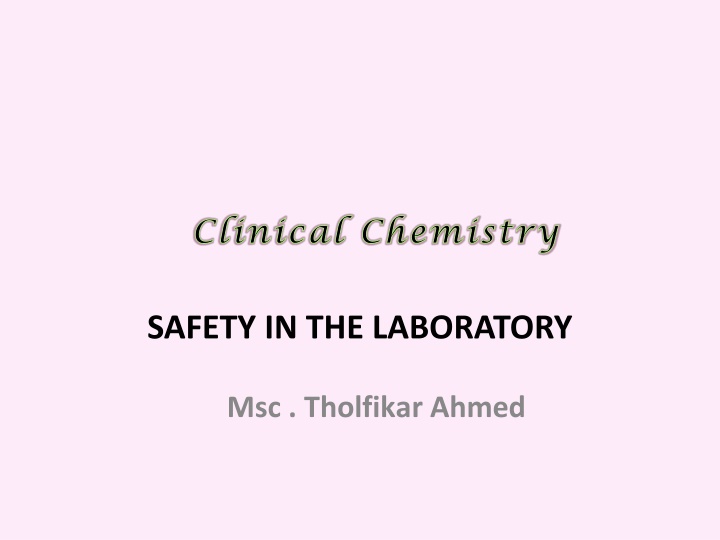
Ensuring Laboratory Safety: Chemical and Biological Hazard Prevention
Planning experiments in a biochemistry laboratory requires careful consideration of safety to protect investigators. Health hazards, such as chemical irritants and corrosive substances, pose risks to individuals. Biological hazards, including infectious fluids and genetically engineered microorganisms, must also be managed to ensure a safe laboratory environment. Learn more about the importance of safety protocols to mitigate potential risks in laboratory settings.
Download Presentation

Please find below an Image/Link to download the presentation.
The content on the website is provided AS IS for your information and personal use only. It may not be sold, licensed, or shared on other websites without obtaining consent from the author. If you encounter any issues during the download, it is possible that the publisher has removed the file from their server.
You are allowed to download the files provided on this website for personal or commercial use, subject to the condition that they are used lawfully. All files are the property of their respective owners.
The content on the website is provided AS IS for your information and personal use only. It may not be sold, licensed, or shared on other websites without obtaining consent from the author.
E N D
Presentation Transcript
Clinical Chemistry Clinical Chemistry SAFETY IN THE LABORATORY Msc . Tholfikar Ahmed
SAFETY IN THE LABORATORY Virtually all experiments conducted in a biochemistry laboratory present a potential risk to the well-being of the investigator. In planning any experiment it is essential 35 1.5 Safety in the laboratory that careful thought be given to all aspects of safety before the experimental design is finalized. Health hazards come from a variety of sources:
SAFETY IN THE LABORATORY 1 - Chemical hazards: All chemicals are, to varying extents, capable of causing damage to the body. They may be irritants and cause a short-term effect on exposure. Alternatively they may be corrosive and cause severe and often irreversible damage to the skin. Examples include strong acids and alkalis
SAFETY IN THE LABORATORY National Fire Protection Association NFPA Chemical label Square Safety
SAFETY IN THE LABORATORY 2 - Biological hazards: Examples include human body fluids that may carry infections such as HIV, laboratory animals that may cause allergic reactions or transmit certain diseases, pathogenic animal and cell tissue cultures, and all microorganisms including genetically engineered forms.
SAFETY IN THE LABORATORY 3 - Electrical and mechanical hazards: All electrical apparatus should be used and maintained in accordance with the manufacturers instructions. Electrophoresis equipment presents a particular potential for safety problems. Centrifuges, especially high-speed varieties, also need careful use especially in the correct use and balance of the rotors. 4 - General laboratory hazards: Common examples include syringe needles, broken glassware and liquid nitrogen flasks.















